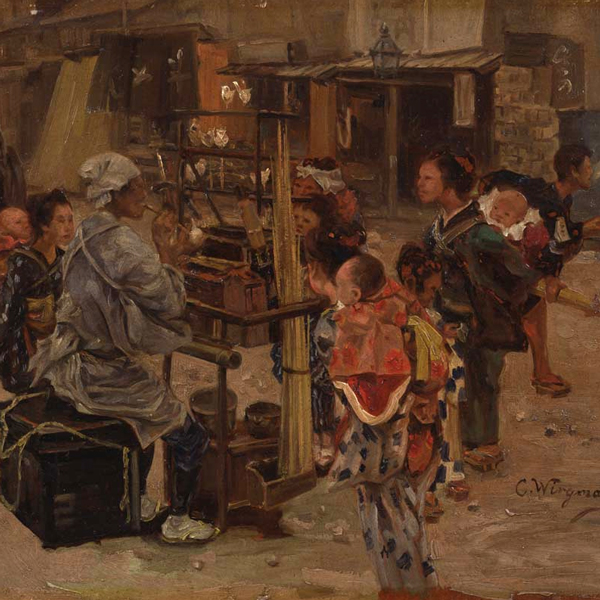Art of the Modern Era | Late 19th–first half of 20th century
-

Candy Vendor (detail), By Charles Wirgman, Meiji era, 19th century
Japanese Gallery (Honkan) Room 18
December 12, 2023 (Tue) - March 3, 2024 (Sun)Drastic changes in the late 19th century created new challenges for artists. The samurai government that had strictly regulated contact with the outside world collapsed in a civil war. Japan's new leaders announced the start of the Meiji era (1868–1912), engaging with the world and reforming their nation to be more like “the West” (mainly Europe and the United States).
These leaders soon realized that works produced in Japan were not seen as “fine art” in the West. Artisans often mounted paintings on sliding doors and folding screens, but this practice made them look like furniture to Europeans and Americans. Japan's ceramics, lacquerware, metalwork, and textiles were also labeled as “decorative art” rather than “fine art.”
In response, artistic traditions were changed to meet Western standards. Japan's leaders established schools of fine art, organized national exhibitions, and urged artists to participate in world fairs. They intended to show the world that Japan was a “modern” nation with sophisticated arts and culture. The works on display reflect how Japanese artists met these challenges.
| Designation | Name | Creation/ Excavation/ Provenance |
Period | Acquisition/ Ownership/ Accession Number |
CMT | ||
| Highlight | Non-Self | By Yokoyama Taikan (1868–1958) | Meiji era, 1897 | A-166 | On exhibit through January 21, 2024 | ||
| Highlight | Plum Blossoms and Lotus Flowers | By Ōchi Shōkan (1882–1958) | Taishō era, 1920 | Gift of Mr. Fukami Kichinosuke, A-12113 | On exhibit from January 23, 2024 | ||
| Highlight | The Legendary Prince Yamato Takeru | By Aoki Shigeru (1882–1911) | Meiji era, 1906 | A-11260 | |||
| Important Cultural Property | Eagle | By Suzuki Chōkichi (1848–1919) | Meiji era, 1892 | Gift of Japan Delegate Office for World's Columbian Exposition, Chicago, E-13034 | |||
| Important Cultural Property | Mount Fuji, Plaque in cloisonné | By Namikawa Sōsuke (1847–1910) | Meiji era, 1893 | Gift of the Japanese Delegate's Office for the World's Columbian Exposition, Chicago, G-603 | |||
| Plaque with a Scene of the "Genjōraku" Dance | By Unno Shōmin (1844–1915) | Meiji era, 1893 | Gift of the Japanese Delegate's Office for the World's Columbian Exposition, Chicago, E-12757 |
